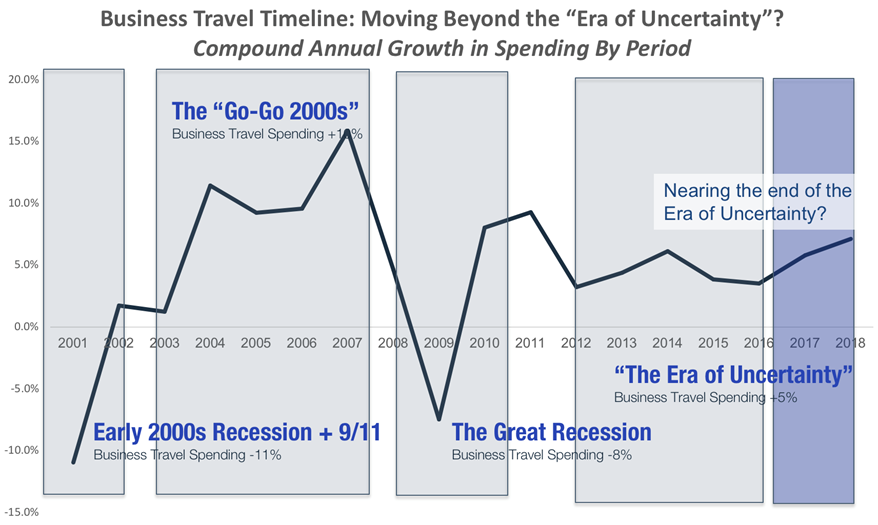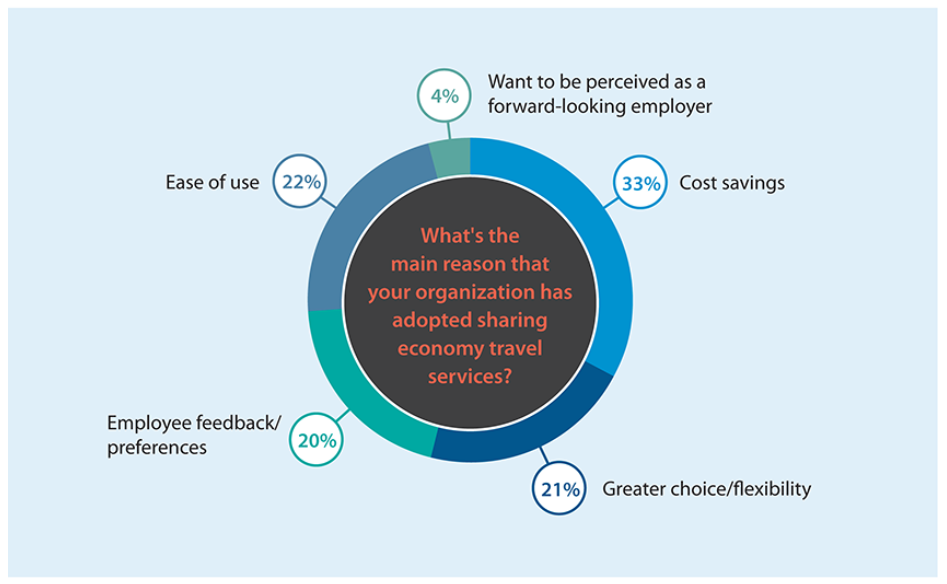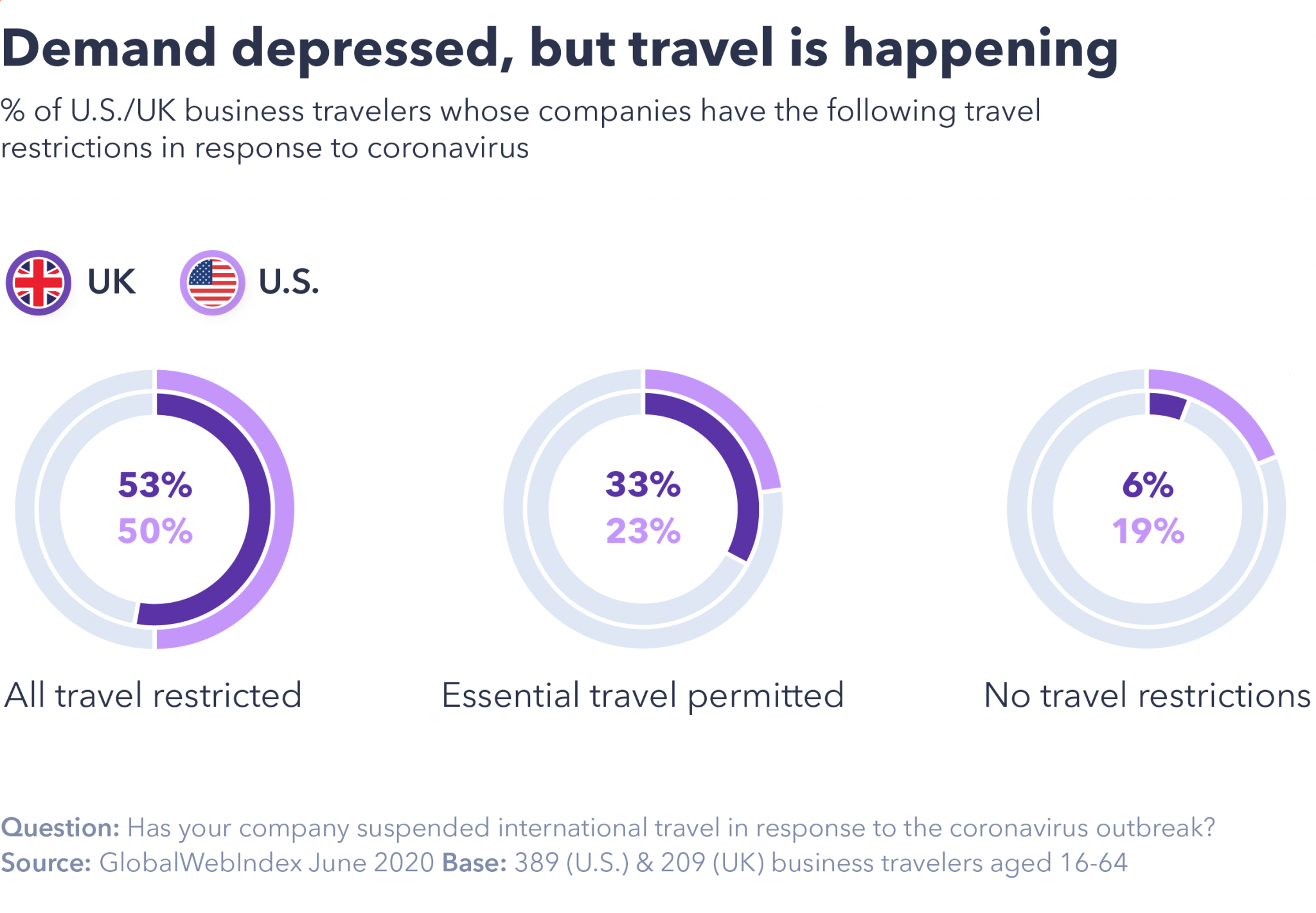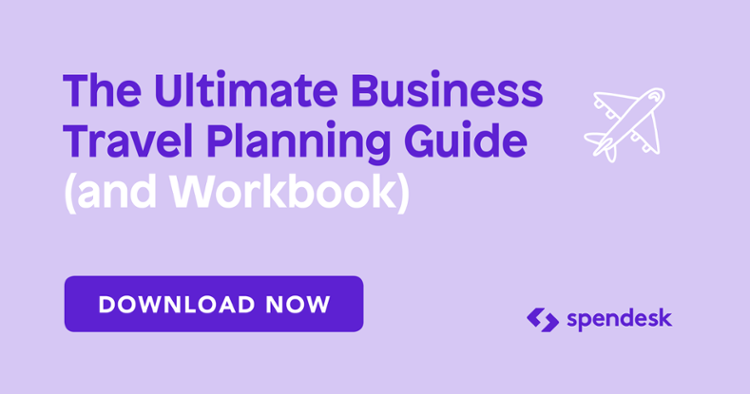)
Let’s start with a statistic right away: travel and tourism accounts for 10.4% of global GDP, and nearly 10% of jobs. That’s enormous!
Business travel makes up a significant portion of that, and companies everywhere need ways to make the process easier and more practical for employees.
In this post, we’ll look at more than 60 interesting statistics that illustrate:
So let’s get right into it, starting with an overview of the business travel industry itself.
The COVID-19 effect on business travel
This post was originally published in early 2019. And while many of the statistics you'll find further down are from this first iteration, the COVID-19 pandemic and ensuing economic crisis have cause massive upheaval in the business travel world.
Here are a few of the most significant results of this situation:
The business travel market worldwide is expected to lose $810.7 bn USD as a result of the pandemic. (Statista)
Two-thirds of global aircraft have been grounded, and 18 airlines have filed for bankruptcy. (McKinsey)
In Q2 2020, US airlines reported a greater than 90% reduction in business travel. (McKinsey)
Company travel managers report business trip spending to be between 5-15% of 2019 levels. (McKinsey)
One survey found that, while business travel had been reduced heavily, some companies had placed no restrictions whatsoever (GlobalWebIndex):
China has seen the greatest reduction in business travel spend at $404bn, followed by Europe and the Asia Pacific region. (Statista)
Studies have found that it takes on average five years for airline traffic to return to normal from substantial "unanticipated shocks." (IATA)
The (classic) state of business travel
The rest of this article reflects the business travel ecosystem prior to the COVID-19 pandemic of early 2020.
Without a doubt, work travel is growing again. The industry took a hit after the global financial crisis in 2008, and followed that with several years of slow growth, if any.
But this is now mostly in the rearview mirror. Business travel is rising, and is expected to continue this trend well into the 2020s. And the new threat to future growth is likely trade wars and tariffs, rather than financial hardship or uncertainty.
So how much travel spending are we talking about?
$1.33tn USD spent on global business travel in 2017 (Statista). This is not a record, but shows an upward trend:

Image source: GBTA
Business travel spending was expected to grow 7.1% in 2018, and top $1.7tn USD by 2022. (GBTA)
For growing European businesses, this growth is already here. Between 2016 and early 2019, average travel spend more than doubled (Spend Trends Report)
76% of those travelers who fly do so to meet a client or visit an out-of-town office. (Fly Aeolus)
China and the U.S. were the top markets in terms of business travel spend, followed by Germany, Japan, and the U.K.:
Image source: GBTA
30% of business flyers take wing once per month, while 62% only travel once per year by plane. (Fly Aeolus)
Coincidentally, 2017 was also the safest year on record for commercial air travel. There were zero accident deaths on commercial flights in 2017. (Business Traveller) By contrast, in 2005 1,015 such deaths occurred.
On top of added safety, many employees take great satisfaction from their ability to travel for work.
Workers love to travel
For some employees, being away from loved ones and routine is stressful. But not everyone sees travel as a burden.
30% of workers (and 43% of Indians) would accept lower salaries in exchange for more business trips. (Booking.com for Business)
90% wanted to continue travelling for business for the rest of their career. (SavvySleeper)
If you’re one of those people who doesn’t enjoy the work travel experience, you’re certainly not alone. But a significant number of travelers love it.
It may mean that you need to examine your company’s travel policies, and look for easier and more enjoyable ways to get around.
Starting with the difficult process of booking travel.
How businesses book travel
Whether for personal travel or business, the process to book flights and accommodation has changed immensely. Sites like TripAdvisor and Expedia have reduced the need for expert advice, while Kayak and Skyscanner mean that you can book trips in record time, from anywhere.
For business, we’ve also seen new companies like TravelPerk emerge to make the booking process easier. And spend management platforms like Spendesk have made paying for travel simple.
So what does the modern travel booking process look like? Personalization and flexibility are key.
57% of travelers want to use a single app to plan, book, and track travel. (Booking.com)
But 50% of business travelers don’t use the travel booking solution provided by their company. (TripActions)
Online is the most popular way to book travel in the U.K., followed by in-store or in-person bookings. (Export.gov)
And mobile phone usage is growing quickly, both for bookings and doing travel itself.
Over 70% of travelers in the U.S. always use their mobile phones while traveling. (Google / PhocusWright)
One of the specific challenges for business travelers is fitting within company travel policies. These can feel restrictive, and often add to the negative feelings that can come with work travel.
How travel policies impact employees
Travel policies are there to guide team members throughout the journey. They tell them what they can spend, and often where they can spend it. And this all helps keep them (and the company) compliant.
So do employees actually respect their company’s travel policy?
In one survey, more than 50% of travellers say they don’t always follow company policy when booking. (Amadeus)
When asked why, 37% say the reason is convenience, 35% say price, and 26% say that the prescribed travel brands are not practical for a particular trip. (Amadeus)
And only 23% of business travellers say that meeting company policy is the top priority when booking a hotel. (Egencia)
Only 62% of business travel bookings in the U.S. comply with company policy. (Egencia)
Moreover, 60% of business travellers don’t even understand the benefits of their travel policy. (Amadeus)
For many travelers, the big issue is flexibility. They want the ability to choose how and when they travel, and some wiggle room when options are limited.
48% of corporate travelers say that the most important aspect of a travel program is the ability to book for themselves. (Egencia) This includes the ability to make changes if necessary.
49% of global business travelers aren’t able to book far enough in advance to meet company policy. (Egencia)
In fact, 23% of business travelers wait until the week before departure to book domestic trips. (Booking.com for Business)
In the end, companies need to create policies and procedures that suit their staff. “The user experience gap that exists between consumer and old-school business travel solutions is obvious even as early as when a traveler is booking his or her trip,” writes TripActions.
“This can lead many to altogether ignore company tools and policies as they look to personal preferences over the company dime, making it very difficult for businesses to track and optimize travel spend.”
Now, let’s look closer at the changing landscape for booking work travel.
The sharing economy
New technology has had a major impact on the everyday lives worldwide. The range of gig economy apps outside of traditional hotels, taxis, and other transport has changed leisure travel forever.
But have these changes had the same effect on business travelers?
AirBnb
In 2014, the well-known homestay service launched AirBnb for Work to specifically tailor to the corporate crowd. So has this endeavor paid off?
700,000 companies used AirBnb for Work in 2018, up from 250,000 in 2016. (PhocusWire)
AirBnb for Work makes up 15% of all AirBnb bookings. (TechCrunch)
But 79% of companies have not incorporated AirBnb into their booking procedures, and 54% have no plans to do so. (Small Business Trends)
 Image source: Small Business Trends | Data source: Chrome River
Image source: Small Business Trends | Data source: Chrome River
Despite this, AirBnb is worth more than $31bn USD, more than most major hotel chains. (VentureBeat)
The fastest-growing segment for work trips on AirBnb is three nights or fewer. (PhocusWire)
60% of AirBnb work trips involve more than one guest. (PhocusWire)
Uber & Lyft
The other poster child for the modern sharing economy has been Uber. The ridesharing company is now active in 65 countries, with more than 75 million riders and 3 million drivers.
More North Americans expensed trips with Uber in 2018 than any other company. (Business Traveller)
And the same is true for growing European companies. Spendesk users travel with Uber more than any other transport provider. (Spend Trends Report)
In fact, Uber now accounts for 11% of entries in American expense reports. (Phocuswire)
And Uber and Lyft are now both in the top 10 vendors appearing on American expense reports. (recode)
Businesses want to let team members travel however suits them. But more importantly, they want to save money:
For ridesharing business travel, Uber accounts for 74% of all trips, while Lyft makes up 19%. (Business Traveller)
And Lyft’s popularity is growing. The app increased its market share among business travelers 70% between 2017 and 2018. (Lyft)
Amazingly, taxis now only represent 7% of ride-hailing trips in the US. (recode)
Whether it’s for convenience, style, or cost-saving, it’s clear that the sharing economy has become a key feature of business travel.
Region-specific travel facts
The travel industry isn’t the same the world over. Different work cultures mean that business travel isn’t viewed the same from market to market.
So what do travel trends look like when we zoom in on certain countries and geographic regions?
EU business travel statistics
What does the travel industry look like in the EU?
Business travel accounts for 22.2% of travel and tourism’s contribution to European GDP. (World Travel & Tourism Council)
In 2017, 58% of nights spent by non-EU residents in Europe were spent in France, Italy, Spain, and the United Kingdom. (Eurostat)
France is the most-visited tourist country in the world, but San Marino, Georgia, Israel, and Turkey were the four fastest-growing destinations in 2018. (Bloomberg)
U.K. business travel statistics
Key details about the corporate travel industry in the U.K.
There were a record number of trips both to and from the U.K. in 2017. (Office of National Statistics)
Image source: Office of National Statistics
Business travel to and from the U.K. actually decreased 0.7% in 2017. (Office of National Statistics)
In 2017, the United Kingdom's business travel spending reached approximately 50.04 billion U.S. dollars (Statista)
All travelers to Scotland (including business visitors) have grown significantly, likely following the Brexit vote. Spending by business travelers to Scotland doubled between 2017 and 2018. (BBC)
U.S. business travel statistics
Useful insights into the state of business travel in the United States.
Business travel accounted for $317.2bn in spending in 2017, compared with $718.4bn for leisure travel. (US Travel Association)
Of this, $131.9bn was used for meetings, events, and incentive programs. (U.S. Travel Association)
U.S. travelers took 466.2mn domestic business trips in 2017, and 1,779.7mn for leisure. (Statista)
Over 40% of business trips in the past year also include a leisure portion. (Expedia)
Asian business travel statistics
Home to several fast-growing economies, what does work travel look like in Asia?
Corporate travelers in Asia account for more than a third of all business travel. The region is the largest in the world for business travel. (McKinsey)
Shanghai, Tokyo, Bangkok, Guangzhou, and New York are the fastest-growing destinations for business travel. (Booking.com for Business)
Asian business travelers are twice as likely as Europeans to make business trips that include a weekend. (McKinsey)
69% of Asian work travelers are given freedom to choose their airline or hotel (from a list, or with no restrictions at all). (McKinsey)
Bleisure travel
More than just a buzzword, “bleisure” travel (business + leisure) has come to represent a significant percentage of all business travel.
About 10% of all business trips are designated “bleisure trips.” (Forbes)
49% of business travelers choose to extend trips to spend more time in a destination. (Booking.com for Business)
70% of 25 to 35 year-olds desire to extend corporate trips for leisure reasons. (Travel Weekly)
“Bleisure” travel (a business trip involving a Saturday night) was up 20% in 2017. (Forbes)
40% of 2017 bleisure trips were for workers in manufacturing, tech, or financial services. (Forbes)
57% of companies allow employees to extend business trips as part of their travel policies. (Forbes)
80% of business travelers set aside personal time while traveling for work. But 38% of travelers think that shouldn’t tell their boss about these bleisure aspects. (NationalCar.com)
Bleisure trips to the Asia/Pacific region saw a 45% increase in 2017, while EMEA was up 46%. (Forbes)
Don’t sleep on business trips
As corporate travel grows and evolves, it’s vital to manage the process of booking and paying effectively. This means giving employees the freedom to handle bookings themselves, and the ability to pay easily while on the road.
And of course, a good travel management tool makes this much easier.
Too many companies approach travel as an afterthought. There are no clear systems in place, and employees are left to figure things out on their own.
This taints the whole experience, and adds more administrative work for your finance team. Every extra hour they have to spend helping travelers is an hour lost.
And in the end work travel should help your business grow, and bring a little excitement to your team members. Don’t take that for granted.





)
)
)
)
)